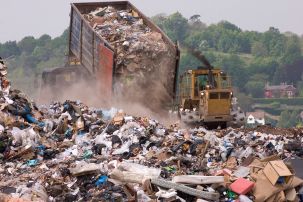Lesson summary
In this students will investigate how a landfill site works. They begin the activity by experimenting with materials used to aid or prevent water movement through a landfill site. They then build a three dimensional model that will show how a landfill works, how it is constructed, the layers in a landfill, the key structures and features of a landfill, how rubbish is added to a landfill and how it is rehabilitated after the landfill site is full.
Learning intentions:
Students will...
- understand that landfill is a site for burying solid waste
- recognise that there are different ways of preparing and constructing a landfill site to minimise environmental harm
- understand that there are a range of environmental and social risks and benefits involved with landfill sites
- recognise the value in using a 3D model to represent the structure and issues of a landfill site.
Lesson guides and printables
Lesson details
Curriculum mapping
Australian Curriculum content descriptions:
Year 9 Science:
- The values and needs of contemporary society can influence the focus of scientific research (ACSHE228)
- Plan, select and use appropriate investigation methods, including field work and laboratory experimentation, to collect reliable data; assess risk and address ethical issues associated with these methods (ACSIS165)
- Select and use appropriate equipment, including digital technologies, to systematically and accurately collect and record data (ACSIS166)
- Use knowledge of scientific concepts to draw conclusions that are consistent with evidence (ACSIS170)
- Communicate scientific ideas and information for a particular purpose, including constructing evidence-based arguments and using appropriate scientific language, conventions and representations (ACSIS174)
Year 10 Science:
- The values and needs of contemporary society can influence the focus of scientific research (ACSHE230)
- Plan, select and use appropriate investigation methods, including field work and laboratory experimentation, to collect reliable data; assess risk and address ethical issues associated with these methods (ACSIS199)
- Select and use appropriate equipment, including digital technologies, to systematically and accurately collect and record data (ACSIS200)
- Use knowledge of scientific concepts to draw conclusions that are consistent with evidence (ACSIS204)
- Communicate scientific ideas and information for a particular purpose, including constructing evidence-based arguments and using appropriate scientific language, conventions and representations (ACSIS208)
Syllabus Outcomes: SC5-11PW, SC5-5WS, SC5-6WS, SC5-7WS, SC5-9WS.
Resources required
- Internet access
- Student worksheet
Materials for each activity:
- Activity 1. For each group: four 250 ml glass beakers, food colouring, water, 100ml measuring cylinder, stop watch, garden soil, sand, clay and gravel.
- Activity 2. For each group: construction materials (such as timber, cardboard, paper mache, chicken wire, small cardboard boxes and tubes, masking tape) water flow materials (gravel, soil, sand, and clay), straws, paint brushes, paint, scissors and other craft cutting tools, small cars and trucks.
Additional info
This is an original Cool.org lesson. Facts and figures in these lessons may have changed since this lesson was published. We always endeavour to update our resources in a timely manner, but if you see an error or issue in our resources please get in touch with us.


Welcome back!
Don't have an account yet?
Log in with:
By signing up to Cool.org you consent and agree to Cool's privacy policy to
store, manage and process your personal information. To read more, please see
our privacy policy here(Opens in new tab).
Create your free Cool.org account.
Many of our resources are free, with an option to upgrade to Cool+ for premium content.
Already have an account?
Sign up with:
By signing up to Cool.org you consent and agree to Cool's privacy policy to
store, manage and process your personal information. To read more, please see
our privacy policy here(Opens in new tab).